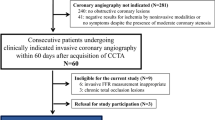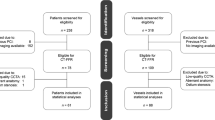Abstract
Purpose of Review
Coronary artery disease (CAD) is the leading cause of mortality in the United States and is accountable for a significant portion of overall healthcare costs. Non-invasive imaging plays a major role in the modern workup of CAD. This article will educate the reader on the foundations of computed tomography-derived fractional flow reserve (CT-FFR) and provide guidance for its appropriate clinical use.
Recent Findings
Coronary computed tomography angiography (CCTA) has high sensitivity and negative predictive value to non-invasively rule out CAD. However, discrimination of ischemia-inducing lesions based on macroscopic anatomy derived from either CCTA or the gold standard for the detection of anatomic stenoses, invasive coronary angiography, is suboptimal. Invasive pressure wire-guided estimation of FFR across coronary stenoses yields reliable functional information regarding the effect of a lesion on myocardial blood supply. Recently, non-invasive methods have attempted to calculate FFR from CCTA datasets. CT-FFR allows for higher specificity compared to CCTA alone, while preserving the high sensitivity and negative predictive value of CCTA. Whereas off-site solutions for CT-FFR calculation have been heavily validated and are clinically available, other techniques that can be performed on-site have recently evolved and are under current investigation.
Summary
Non-invasive CT-FFR has facilitated the reliable assessment of the hemodynamic significance of coronary artery stenosis, potentially increasing the specificity of the modality while maintaining its excellent sensitivity.
Similar content being viewed by others
References
Recently published papers of particular interest have been highlighted as: • Of importance •• Of major importance
Tonino PA, et al. Angiographic versus functional severity of coronary artery stenoses in the FAME study fractional flow reserve versus angiography in multivessel evaluation. J Am Coll Cardiol. 2010;55(25):2816–21.
De Bruyne B, et al. Transstenotic coronary pressure gradient measurement in humans: in vitro and in vivo evaluation of a new pressure monitoring angioplasty guide wire. J Am Coll Cardiol. 1993;22(1):119–26.
•• Tonino PA, et al. Fractional flow reserve versus angiography for guiding percutaneous coronary intervention. N Engl J Med. 2009;360(3):213–24. Study showed that FFR measurement was more accurate and superior in decision making in determining the impact of coronary stenoses on myocardial blood supply than anatomic assessment by ICA.
Fearon WF, et al. Cost-effectiveness of measuring fractional flow reserve to guide coronary interventions. Am Heart J. 2003;145(5):882–7.
Fearon WF. Percutaneous coronary intervention should be guided by fractional flow reserve measurement. Circulation. 2014;129(18):1860–70.
Bech GJ, et al. Fractional flow reserve to determine the appropriateness of angioplasty in moderate coronary stenosis: a randomized trial. Circulation. 2001;103(24):2928–34.
Pijls NH, et al. Percutaneous coronary intervention of functionally nonsignificant stenosis: 5-year follow-up of the DEFER Study. J Am Coll Cardiol. 2007;49(21):2105–11.
Zimmermann FM, et al. Deferral vs. performance of percutaneous coronary intervention of functionally non-significant coronary stenosis: 15-year follow-up of the DEFER trial. Eur Heart J. 2015;36(45):3182–8.
Krone RJ, et al. Ad hoc percutaneous coronary interventions in patients with stable coronary artery disease—a study of prevalence, safety, and variation in use from the American College of Cardiology National Cardiovascular Data Registry (ACC-NCDR). Catheter Cardiovasc Interv. 2006;68(5):696–703.
Orvin K, et al. Fractional flow reserve application in everyday practice: adherence to clinical recommendations. Cardiovasc Diagn Ther. 2013;3(3):137–45.
Hannawi B, et al. Current use of fractional flow reserve: a nationwide survey. Tex Heart Inst J. 2014;41(6):579–84.
Gonzalez JA, et al. Meta-analysis of diagnostic performance of coronary computed tomography angiography, computed tomography perfusion, and computed tomography-fractional flow reserve in functional myocardial ischemia assessment versus invasive fractional flow reserve. Am J Cardiol. 2015;116(9):1469–78.
Taylor CA, Fonte TA, Min JK. Computational fluid dynamics applied to cardiac computed tomography for noninvasive quantification of fractional flow reserve: scientific basis. J Am Coll Cardiol. 2013;61(22):2233–41.
Stergiopulos N, Young DF, Rogge TR. Computer simulation of arterial flow with applications to arterial and aortic stenoses. J Biomech. 1992;25(12):1477–88.
•• Koo BK, et al. Diagnosis of ischemia-causing coronary stenoses by noninvasive fractional flow reserve computed from coronary computed tomographic angiograms. Results from the prospective multicenter DISCOVER-FLOW (diagnosis of ischemia-causing stenoses obtained via noninvasive fractional flow reserve) study. J Am Coll Cardiol. 2011;58(19):1989–97. First large scale international multicenter study comparing diagnostic accuracy of CT-FFR to invasive FFR measurement. Demonstraded superiority of diagnostic accuracy of CT-FFR over CCTA alone.
Sharma P, et al. A framework for personalization of coronary flow computations during rest and hyperemia. Conf Proc IEEE Eng Med Biol Soc. 2012;2012:6665–8.
Itu L, et al. A machine-learning approach for computation of fractional flow reserve from coronary computed tomography. J Appl Physiol. 2016;121(1):42–52.
• Renker M, et al. Comparison of diagnostic value of a novel noninvasive coronary computed tomography angiography method versus standard coronary angiography for assessing fractional flow reserve. Am J Cardiol. 2014;114(9):1303–8. First study to investigate an on-site solution for CT-FFR calculation. Results showed superior diagnostic performance of cFFR over CCTA alone.
Min JK, et al. Diagnostic accuracy of fractional flow reserve from anatomic CT angiography. JAMA. 2012;308(12):1237–45.
•• Abbara S, et al. SCCT guidelines for performance of coronary computed tomographic angiography: a report of the Society of Cardiovascular Computed Tomography Guidelines Committee. J Cardiovasc Comput Tomogr. 2009;3(3):190–204. Second large scale international multicenter study comparing diagnostic accuracy of CT-FFR to invasive FFR measurement. Although noth having met primary study goals, led to refinements in FFR CT software and implementation of stricter acqusition guidelines for FFR CT .
•• Norgaard BL, et al. Diagnostic performance of noninvasive fractional flow reserve derived from coronary computed tomography angiography in suspected coronary artery disease: the NXT trial (analysis of coronary blood flow using CT angiography: next steps). J Am Coll Cardiol. 2014;63(12):1145–55. Latest large scale international multicenter study comparing diagnostic accuracy of CT-FFR to invasive FFR measurement. Demonstraded superiority of diagnostic accuracy of CT-FFR over CCTA alone.
• Kruk M, et al. Workstation-based calculation of CTA-based FFR for intermediate stenosis. JACC Cardiovasc Imaging. 2016;9(6):690–9. Study concluded that CT-FFR may distinguish between ischemic and nonischemic coronary stenoses in around one half of patients with intermediate stenosis.
• Wang R, et al. Diagnostic value of quantitative stenosis predictors with coronary CT angiography compared to invasive fractional flow reserve. Eur J Radiol. 2015;84(8):1509–15. Study to investigate an on-site solution for CT-FFR calculation. Results showed superior diagnostic performance of cFFR over CCTA alone.
• Coenen A, et al. Fractional flow reserve computed from noninvasive CT angiography data: diagnostic performance of an on-site clinician-operated computational fluid dynamics algorithm. Radiology. 2015;274(3):674–83. Study to investigate an on-site solution for CT-FFR calculation. Results showed superior diagnostic performance of cFFR over CCTA alone.
Baumann S, et al. Coronary CT angiography-derived fractional flow reserve correlated with invasive fractional flow reserve measurements–initial experience with a novel physician-driven algorithm. Eur Radiol. 2015;25(4):1201–7.
Yang DH, et al. Diagnostic performance of on-site CT-derived fractional flow reserve versus CT perfusion. Eur Heart J Cardiovasc Imaging. 2017;18(4):432–40.
Rizvi A, et al. Rationale and design of the CREDENCE Trial: computed TomogRaphic evaluation of atherosclerotic DEtermiNants of myocardial IsChEmia. BMC Cardiovasc Disord. 2016;16(1):190.
Pontone G, et al. Rationale and design of the PERFECTION (comparison between stress cardiac computed tomography PERfusion versus fractional flow rEserve measured by Computed Tomography angiography In the evaluation of suspected cOroNary artery disease) prospective study. J Cardiovasc Comput Tomogr. 2016;10(4):330–4.
Truong QA, et al. Rationale and design of the dual-energy computed tomography for ischemia determination compared to “gold standard” non-invasive and invasive techniques (DECIDE-Gold): a multicenter international efficacy diagnostic study of rest-stress dual-energy computed tomography angiography with perfusion. J Nucl Cardiol. 2015;22(5):1031–40.
Kushner FG, et al. 2009 focused updates: ACC/AHA Guidelines for the management of patients with ST-elevation myocardial infarction (updating the 2004 Guideline and 2007 Focused Update) and ACC/AHA/SCAI Guidelines on Percutaneous Coronary Intervention (updating the 2005 Guideline and 2007 Focused Update): a report of the American College of Cardiology Foundation/American Heart Association Task Force on Practice Guidelines. Circulation. 2009;120(22):2271–306.
Pijls NH, et al. Fractional flow reserve versus angiography for guiding percutaneous coronary intervention in patients with multivessel coronary artery disease: 2-year follow-up of the FAME (fractional flow reserve versus angiography for multivessel evaluation) study. J Am Coll Cardiol. 2010;56(3):177–84.
Curzen NP, et al. Does the routine availability of CT-derived FFR influence management of patients with stable chest pain compared to CT angiography alone?: the FFRCT RIPCORD Study. JACC Cardiovasc Imaging. 2016;9(10):1188–94.
Douglas PS, et al. Clinical outcomes of fractional flow reserve by computed tomographic angiography-guided diagnostic strategies vs. usual care in patients with suspected coronary artery disease: the prospective longitudinal trial of FFR(CT): outcome and resource impacts study. Eur Heart J. 2015;36(47):3359–67.
Douglas PS, et al. 1-year outcomes of FFRCT-guided care in patients with suspected coronary disease: the PLATFORM Study. J Am Coll Cardiol. 2016;68(5):435–45.
Lu MT, et al. Noninvasive FFR derived from coronary CT angiography: management and outcomes in the PROMISE trial. JACC Cardiovasc Imaging. 2017. doi:10.1016/j.jcmg.2016.11.024 [Epub ahead of print].
Chinnaiyan KM, et al. Rationale, design and goals of the HeartFlow assessing diagnostic value of non-invasive FFRCT in Coronary Care (ADVANCE) registry. J Cardiovasc Comput Tomogr. 2017;11(1):62–7.
Author information
Authors and Affiliations
Corresponding author
Ethics declarations
Conflict of interest
Philipp von Knebel Doeberitz, Moritz H. Albrecht, John W. Nance, Brian Jacobs, Marwen Eid, Domenico De Santis, Thomas Henzler, and Stefan O. Schoenberg each declare no potential conflicts of interest. Carlo N. De Cecco receives research support from Siemens. U. Joseph Schoepf is a consultant for and/or receives research support from Astellas, Bayer, GE, Guerbet, Medrad, and Siemens. Dr. Schoepf is a section editor for Current Radiology Reports.
Human and Animal Rights and Informed Consent
This article does not contain any studies with human or animal subjects performed by any of the authors.
Additional information
This article is part of the Topical Collection on New Imaging Technologies.
Rights and permissions
About this article
Cite this article
von Knebel Doeberitz, P., Albrecht, M.H., De Cecco, C.N. et al. Coronary CT-Derived Fractional Flow Reserve. Curr Radiol Rep 5, 40 (2017). https://doi.org/10.1007/s40134-017-0234-8
Published:
DOI: https://doi.org/10.1007/s40134-017-0234-8




